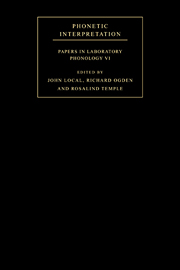Book contents
- Frontmatter
- Contents
- List of contributors
- Acknowledgements
- Introduction
- Part I Phonological representations and the lexicon
- Part II Phonetic interpretation and phrasal structure
- Part III Phonetic interpretation and syllable structure
- Part IV Phonology and natural speech production: tasks, contrasts and explanations
- 16 The interaction of the phonetics and phonology of gutturals
- 17 Pitch discrimination during breathy versus modal phonation
- 18 The phonetic interpretation of register: evidence from Yorùbá
- 19 Speech rhythm in English and Japanese
- 20 Commentary: on the interpretation of speakers' performance
- References
- Index of names
- Index of subjects
16 - The interaction of the phonetics and phonology of gutturals
Published online by Cambridge University Press: 22 September 2009
- Frontmatter
- Contents
- List of contributors
- Acknowledgements
- Introduction
- Part I Phonological representations and the lexicon
- Part II Phonetic interpretation and phrasal structure
- Part III Phonetic interpretation and syllable structure
- Part IV Phonology and natural speech production: tasks, contrasts and explanations
- 16 The interaction of the phonetics and phonology of gutturals
- 17 Pitch discrimination during breathy versus modal phonation
- 18 The phonetic interpretation of register: evidence from Yorùbá
- 19 Speech rhythm in English and Japanese
- 20 Commentary: on the interpretation of speakers' performance
- References
- Index of names
- Index of subjects
Summary
Introduction
Arabic and Interior Salish languages are distinguished from other languages in having a wide variety of consonant series that have constrictions in the back part of the vocal tract. These include pharyngeals, uvulars and uvularised segments. These languages are similar in that the pharyngeals, uvulars and emphatics seem to pattern together and form a natural class with respect to a variety of phonological processes. This natural class is generally called the guttural natural class. However, these two language groups differ in that while the laryngeal consonants [?] and [h] of Arabic behave as members of the guttural class, the laryngeals of Salish usually cannot be grouped with gutturals. One important question is why these language groups differ in their treatment of the laryngeal consonants.
McCarthy (1994) and Hayward and Hayward (1989) raised a more general question: why would the emphatics, uvulars, pharyngeals (and laryngeals in Arabic) be a natural class in the first place? In Feature Geometry (Halle 1995; Sagey 1986; McCarthy 1988), feature nodes, which define natural classes, are associated with active articulators. McCarthy (1994) reviews a number of phonetic studies of Arabic and concludes that the guttural class presents a problem for this view; there is no single active articulator for the gutturals. There have been two previous proposals that attempted to address this problem. The first, which is the generally accepted analysis, is to allow for ‘articulatory zones’ (Hayward and Hayward 1989; Vaux 1993; McCarthy 1994; Halle 1995; Rose 1996).
- Type
- Chapter
- Information
- Phonetic InterpretationPapers in Laboratory Phonology VI, pp. 279 - 292Publisher: Cambridge University PressPrint publication year: 2004



